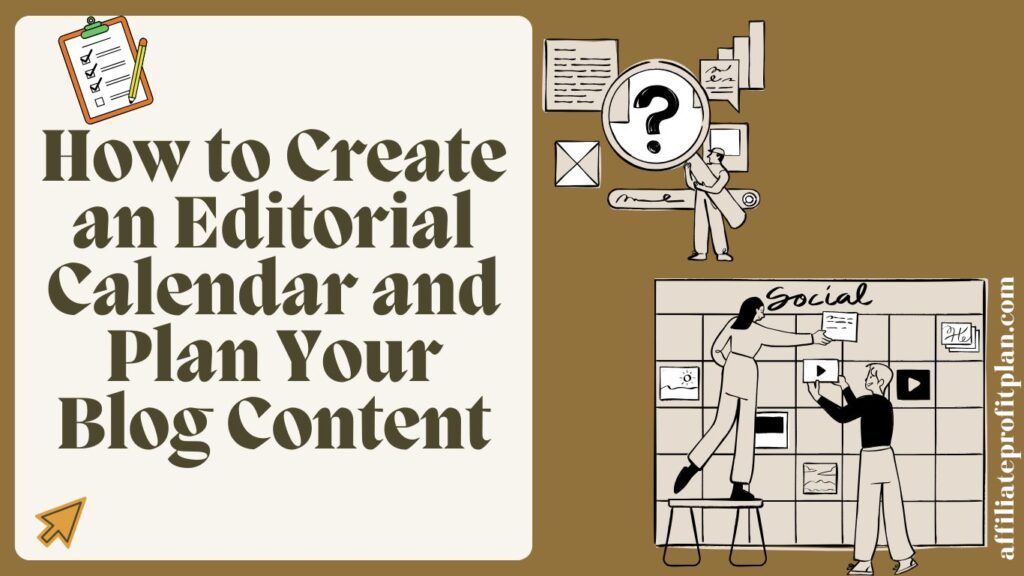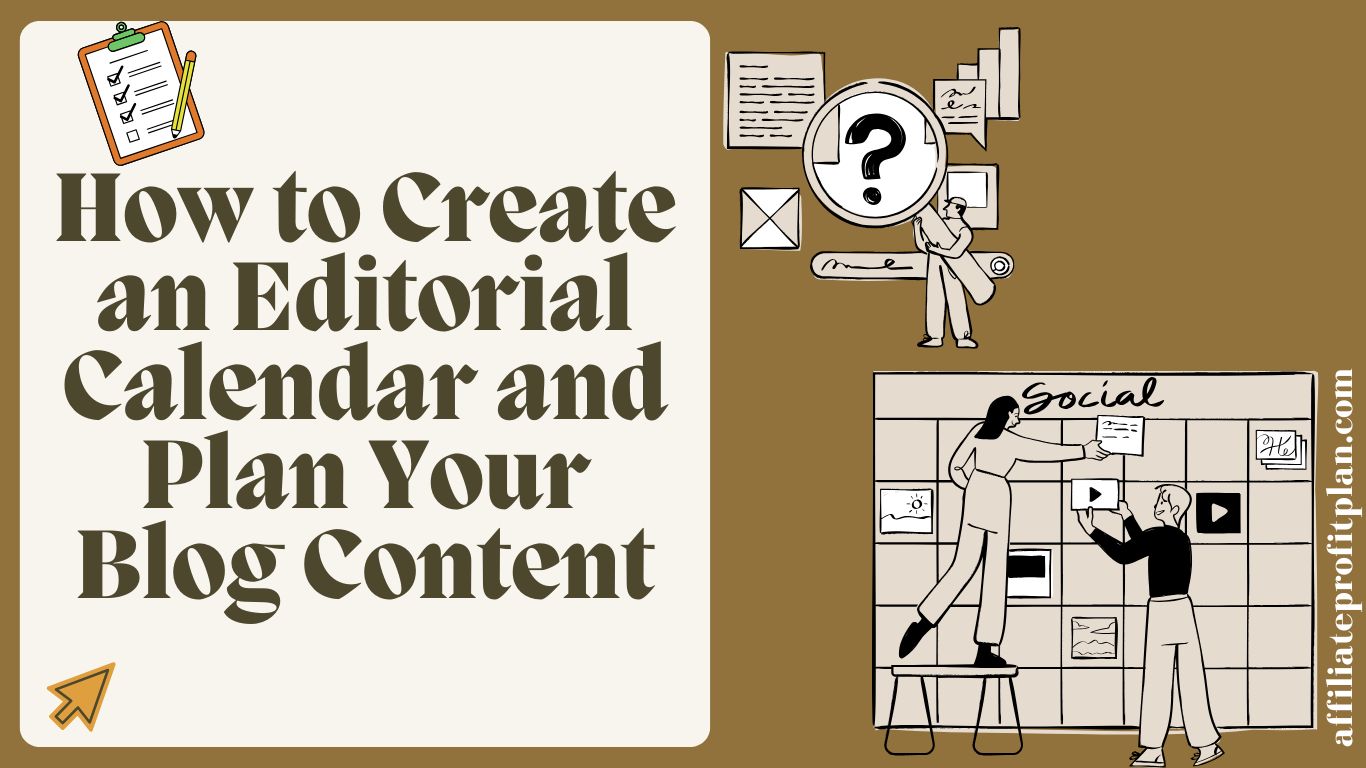Welcome to my article How to Create an Editorial Calendar and Plan Your Blog Content. As a blogger, you’ve probably experienced the rush of inspiration, cranking out a killer post only to realize—you’ve got nothing planned for next week. And now, you’re scrambling for ideas, pulling all-nighters, and trying to come up with content that doesn’t sound like a half-baked grocery list. Sound familiar? Well, it’s time to put an end to that madness. The solution: an editorial calendar.
In this post, I’ll walk you through how to create an editorial calendar that works for you, from choosing the right tools to planning content that hits all the right notes. By the end, you’ll have a solid plan in place to keep your blog on track—and maybe even make blogging feel like less of a chaotic rollercoaster ride. Buckle up, it’s time to get organized!
Access My Proven Blueprint for $50-$100 Daily Income – Watch This FREE Video Now >>>

Why You Need an Editorial Calendar
Let me guess: you’ve probably been there. You sit down to write a blog post, get hit with a wave of panic, and think, “What on earth am I going to write about today?” Sound familiar? Without a clear plan in place, it’s like trying to navigate a maze without a map—you’re bound to hit a few dead ends. Enter the editorial calendar: your blogging GPS to guide you through the content creation journey.
First off, an editorial calendar helps you stay organized. Think about it—if you’re just winging it every time you sit down to blog, it’s easy to end up posting inconsistently. One week you’ve got a post up, the next? Nada. But with a calendar, you can map out your content in advance and create a realistic posting schedule. It’s like having a friend who nudges you with a reminder every time you forget to do your homework. But, you know, in a non-judgmental way. 😎
Another huge perk? An editorial calendar helps you avoid content burnout. We’ve all been there: stressing over topics, scrambling for inspiration, and eventually writing a post that just feels like a rushed afterthought. With an editorial calendar, you’re not just throwing darts at a board hoping something sticks. You get to plan your content strategically, ensuring a mix of topics, post formats, and even SEO-friendly keywords. By looking at your calendar, you can keep things fresh and avoid that dreaded content block.
And let’s not forget about consistency! Whether you’re posting once a week, biweekly, or monthly, consistency is key in the blogging world. An editorial calendar helps you stay accountable, ensuring that you’re regularly producing content that keeps your audience engaged. It’s like having a workout plan for your blog—skip leg day (or content day) once, and you’ll feel it. But stay on track, and you’ll be seeing results in no time!
In short, an editorial calendar isn’t just a fancy organizational tool—it’s your secret weapon for blogging success. No more chaos, no more scrambling, just a smooth, well-thought-out content strategy that will keep your blog in tip-top shape.
Choosing the Right Tools for Your Editorial Calendar
Alright, now that you’re convinced of the magic an editorial calendar can work, let’s talk about choosing the right tools to bring your content planning to life. Because, let’s face it, a calendar can only do so much if it’s buried under piles of sticky notes or hiding in the depths of a half-empty notebook (we’ve all been there). Finding the perfect tool is key to staying organized, on track, and—most importantly—not losing your mind.
First up, let’s start with the tried-and-true classics: Google Sheets or Excel. These may sound like the most basic of options, but don’t let that fool you—they’re the unsung heroes of content planning. With just a simple spreadsheet, you can create a calendar that suits your needs. Add columns for post titles, deadlines, keywords, and publishing dates. You can color-code, add links, and even make those little notes to yourself that say things like, “Remember to breathe.” Plus, Google Sheets is free, easily shareable, and accessible from anywhere—what’s not to love?
But maybe you’re someone who craves a little more visual organization. Enter Trello or Asana—the team collaboration tools that can double as your content-planning dream team. These tools use boards and cards to organize your tasks, and they make moving content ideas around feel like a game of Tetris (in a good way). You can add due dates, checklists, labels, and even attach documents—so much more than just a calendar. If you’re working with a team or just like seeing things laid out visually, these tools are a game-changer. Plus, with the mobile apps, you’ll never have to worry about forgetting a deadline again (no more late-night, panic-stricken emails).
If you’re already knee-deep in WordPress, you might want to look into editorial calendar plugins like Editorial Calendar or CoSchedule. These options integrate seamlessly with your blog, allowing you to manage your posts directly within the WordPress dashboard. CoSchedule even lets you plan your social media posts, so you can kill two birds with one stone. Plus, with WordPress plugins, you’re not jumping between multiple apps—everything’s right there, nice and tidy.
Then there’s Airtable and Notion—fancy tools that look like something out of a Silicon Valley startup meeting. Both offer more customization than you’d get with Google Sheets but still retain that easy-to-use interface. Airtable, for example, lets you create a super slick calendar view with extra details like post categories, team assignments, and progress tracking. If you’re the kind of person who enjoys making everything look organized (because, let’s be honest, a well-organized calendar feels like a personal achievement), these tools are for you.
Ultimately, the key to picking the right tool is to keep it simple—don’t overcomplicate things, especially if you’re just starting. Pick a tool that matches your workflow, whether that’s a spreadsheet, a visual tool, or something more specialized. And hey, if all else fails, grab a physical planner and go old-school. There’s something oddly satisfying about crossing off tasks with a pen, right? ✍️
So whether you’re a spreadsheet aficionado, a Trello enthusiast, or a Notion pro, the perfect editorial calendar tool is out there waiting for you. And with the right one in hand, you’ll be on your way to planning your blog content like a pro in no time.
How to Plan and Organize Your Blog Content
Now that you’ve got your editorial calendar ready and your tools in place, it’s time to dive into the fun part: planning and organizing your blog content. This is where all the magic happens, where you take your brilliant ideas and transform them into a well-structured, engaging blog that’ll have your readers coming back for more. But before you start writing about every little thought that pops into your head (we’ve all been there), let’s get a little strategic.
Access My Proven Blueprint for $50-$100 Daily Income – Watch This FREE Video Now >>>
First, you need to establish your content pillars. Think of these as the main categories or themes that will guide your blog’s direction. Whether you’re a travel blogger, a food enthusiast, or a finance guru, your content pillars will serve as the foundation of your blog. These topics should align with your audience’s interests and, of course, your expertise. For example, if you’re running a fitness blog, your pillars might be things like workouts, nutrition, motivation, and mental health. This will ensure that every post you create ties back to your overall theme, giving your blog a sense of cohesion and direction.
Once you have your pillars in place, the next step is to map out specific blog post ideas under each category. Don’t just think “I’ll write about fitness” and leave it at that—get granular. Create a list of specific topics that fall under each pillar. For example, under the nutrition pillar, you might write posts about meal prep tips, nutritional benefits of certain foods, or how to stick to a diet while traveling. The more detailed your topics are, the easier it will be to write them. Plus, it takes the guesswork out of what to write about next.
Keyword research is another important part of content planning that can’t be overlooked. This is where you make sure your blog posts aren’t just fun to write but also SEO-friendly. Using tools like Google Keyword Planner, Ahrefs, or Ubersuggest, you can find high-ranking keywords in your niche that will help your posts get discovered. Make sure you’re targeting long-tail keywords, which are longer, more specific phrases that people search for (like “beginner workout routines for home”). Incorporating these keywords into your titles, headers, and throughout your content will give your posts a much better shot at ranking on search engines. It’s like setting your blog up for success before you even write a word.
Next, think about the types of content you want to create. Are you going to post in-depth how-tos, listicles, interviews, product reviews, or quick tips? Mixing it up is a great way to keep things interesting and engage different segments of your audience. For example, you could alternate between long-form, SEO-driven posts and shorter, more casual ones. By having a balance of content types, you’ll cater to a wider range of readers, from those who prefer detailed articles to those who want quick, snackable tips.
Finally, don’t forget about seasonal and timely content. Keeping an eye on the calendar is crucial for planning content that resonates with current trends or upcoming events. For example, if you’re writing a food blog, creating content around the holidays, back-to-school season, or even summer BBQs can give you fresh, timely ideas. Not only will these posts tap into seasonal traffic, but they also show your audience that you’re staying relevant and in-the-know.
With your content pillars, detailed ideas, SEO research, and content types mapped out, you’ll have a blog that’s not only organized but also strategic. And trust me, nothing beats the feeling of having a well-planned blog schedule that leaves you with plenty of time to grab that coffee and relax, instead of scrambling for ideas at the last minute.
Setting a Publishing Schedule That Works for You
Alright, now that you’ve got your content all planned out and organized like a boss, it’s time to tackle the publishing schedule. This is where many bloggers get tripped up. You might think, “I can just publish whenever, right?” Well, sure, but if you’re aiming to build an audience, keep things consistent, and not burn out by week two, a solid publishing schedule is your best friend.
First things first: figure out what works for YOU. Are you an early riser, tapping away at the keyboard before your first cup of coffee? Or are you a night owl, cranking out posts after the world has gone to sleep? Everyone’s productivity peaks at different times, so don’t force yourself into a schedule that doesn’t align with your natural flow. If you’re most inspired in the evenings, don’t feel pressured to follow a strict 9-to-5 publishing rhythm just because someone else says you should. The key is consistency, not adhering to someone else’s timetable. Your schedule should complement your lifestyle, not add stress.
Now, how often should you post? That depends on a few factors. If you’re just starting, it’s okay to start slow and gradually ramp up. Maybe aim for one post per week at first. This gives you the time to hone your writing skills, refine your SEO game, and still keep your sanity intact. But as your blog grows and your content creation skills improve, you might find that you can increase your posting frequency. There’s no magic number here, but the more consistent you are, the better. Posting weekly or bi-weekly is a good place to start for most bloggers. It’s enough to build momentum without leaving you feeling like you’re stuck in a content-producing hamster wheel.
To make your schedule even more manageable, consider batching your content. Instead of writing one post per week from scratch, why not spend a few hours at the beginning of the month drafting multiple posts? That way, when life gets busy (because, you know, it always does), you’ll already have content ready to go. You can set aside a day or two for content creation, and then schedule posts to publish throughout the month. Not only does this make the process feel less overwhelming, but it also gives you some breathing room to focus on other aspects of blogging—like optimizing your posts for SEO, managing your social media, or taking a well-deserved nap. 😴
Once you’ve decided how often to publish, make sure to schedule everything in your calendar. This is where having that trusty editorial calendar comes in handy. Use it to map out which posts will go live on which days, and set reminders to keep yourself on track. Pro tip: Don’t wait until the day before to start writing. Give yourself enough time to create high-quality content, edit it, and schedule it for publication ahead of time. Trust me, future-you will thank you.
Lastly, don’t forget about flexibility. Life happens—whether it’s a sick day, a holiday, or a last-minute project that needs your attention. Don’t stress if you miss a posting date. The goal isn’t to make your blog feel like a burden; it’s to create a schedule that works for you and helps you stay consistent without sacrificing your well-being. Think of your schedule as a guide, not a rigid rulebook. If something comes up, just adjust your plan and keep moving forward. Your audience will appreciate the consistency, but they’ll also understand that life is, well, life.
In the end, setting a publishing schedule isn’t about following a one-size-fits-all approach. It’s about finding that sweet spot where you can produce quality content, stay consistent, and still have time for other aspects of life. With a solid plan in place, you’ll be blogging with confidence, hitting those deadlines, and (hopefully) still having time to binge-watch your favorite shows.
Reviewing and Updating Your Editorial Calendar
Congrats! You’ve made it this far. Your editorial calendar is all set up, your blog posts are flowing, and you’re officially a content creation machine. But here’s the thing: your editorial calendar isn’t a static, one-and-done document that you can forget about. Nope, it needs a little TLC from time to time to stay fresh, relevant, and aligned with your ever-evolving blog goals. That’s where reviewing and updating comes into play.
First of all, don’t wait until the end of the year to do a major overhaul. Ideally, you should be checking in with your editorial calendar on a monthly basis—or at least every couple of months. This gives you the chance to assess how things are going, whether your content is still resonating with your audience, and if any new opportunities have popped up that you want to jump on. Maybe there’s a trending topic in your niche that you’d like to cover, or perhaps you’ve noticed that certain posts are performing better than others. By reviewing your calendar regularly, you can keep things current and on-track.
Another key point to consider is the seasonality of your content. Let’s say you’re running a blog that’s all about gardening. Now, the best time to write about planting spring flowers is, well, in the spring! By reviewing your editorial calendar, you can ensure you’re publishing content that matches the seasonal needs of your audience. You don’t want to be posting about summer lawn care when everyone is shivering through winter, right? By staying aware of these shifts in timing, you can stay ahead of the curve and make sure your content aligns with what your readers are looking for at any given moment.
But let’s not forget about your growth as a blogger. As you get more experience, you’ll likely find that your content strategy, writing style, or overall goals evolve. Perhaps when you first started, you were all about quick tips and lists. Now, you might feel more confident in writing longer, more in-depth pieces or tackling more complex topics. Your editorial calendar should reflect these changes. If you find that you’re moving toward more comprehensive content, make adjustments so that your topics, deadlines, and posting schedule reflect your new approach. This helps prevent your content from feeling stale or out of sync with your growing abilities.
Also, let’s talk about traffic trends. If your blog is starting to gain momentum, you may find that your old content is attracting more readers than ever before. That means it might be time to revisit and update older posts. Maybe a post you wrote a year ago is still getting some good organic traffic, but it could use a fresh round of optimization, new images, or a couple of new links to keep it current. Scheduling time in your editorial calendar to go back and refresh your older content ensures that your entire blog stays relevant, even as new posts continue to roll out.
And here’s a pro tip: When reviewing your editorial calendar, don’t forget to ask yourself if you’re still having fun with your content. If you’re feeling uninspired or burned out, maybe it’s time to mix things up. If you’ve been posting the same type of content for a while, spice it up with new content formats—whether that’s incorporating videos, running guest posts, or experimenting with interactive content like polls and quizzes. A little creativity can go a long way in revitalizing both your content and your excitement for blogging.
Lastly, stay flexible. Life happens, and things don’t always go according to plan (shocking, I know). You might get inspired by a new topic and decide to switch gears, or maybe a personal event will shift your priorities for a week or two. That’s okay! The beauty of an editorial calendar is that you can adjust it as needed. So, if something comes up, don’t panic. Move things around, reassign deadlines, and give yourself the room to pivot without losing your rhythm.
In short, reviewing and updating your editorial calendar isn’t about constantly reinventing the wheel—it’s about making sure your plan continues to work for you. It’s a tool, not a rulebook, and when you give it the attention it needs, it’ll serve you well by keeping your blog organized, fresh, and in tune with both your goals and your audience’s needs. So go ahead—grab that cup of coffee, take a moment to assess, and keep your blog running like a well-oiled content machine!
Conclusion: Staying Consistent and Organized for Blogging Success
Let’s be honest—blogging isn’t just about typing out a few thoughts and hitting publish. If that were the case, we’d all be internet-famous by now. The truth is, successful blogging requires a mix of creativity, strategy, and (yep) organization. That’s why having an editorial calendar isn’t just a “nice-to-have”—it’s an absolute game-changer.
Access My Proven Blueprint for $50-$100 Daily Income – Watch This FREE Video Now >>>
By now, you’ve seen how an editorial calendar can help you stay on track, avoid last-minute panic-posting, and actually enjoy the blogging process instead of constantly scrambling for your next idea. It’s like having a personal assistant for your blog—except this one doesn’t demand coffee breaks or paid vacations. With a clear schedule in place, you’re not just throwing content into the void and hoping for the best; you’re building a consistent, well-planned content strategy that keeps your audience engaged and coming back for more.
But here’s the catch: consistency doesn’t mean rigidity. Life happens. Trends shift. Sometimes, that “brilliant” blog idea from three months ago suddenly feels irrelevant. That’s okay! The best bloggers know how to adapt, adjust, and keep moving forward. Your editorial calendar is a guide, not a prison sentence—so use it to keep yourself accountable while leaving room for flexibility when needed.
At the end of the day, blogging success isn’t about who posts the most content the fastest. It’s about who can stay in the game long enough to make an impact. So, whether you’re scheduling posts a month in advance or tweaking your plan as you go, staying organized and consistent will always put you ahead. Now, go forth and blog like a pro—your future audience (and your sanity) will thank you!
Thanks a lot for reading my article on “How to Create an Editorial Calendar and Plan Your Blog Content” till the end. Hope you’ve helped. See you with another article.










